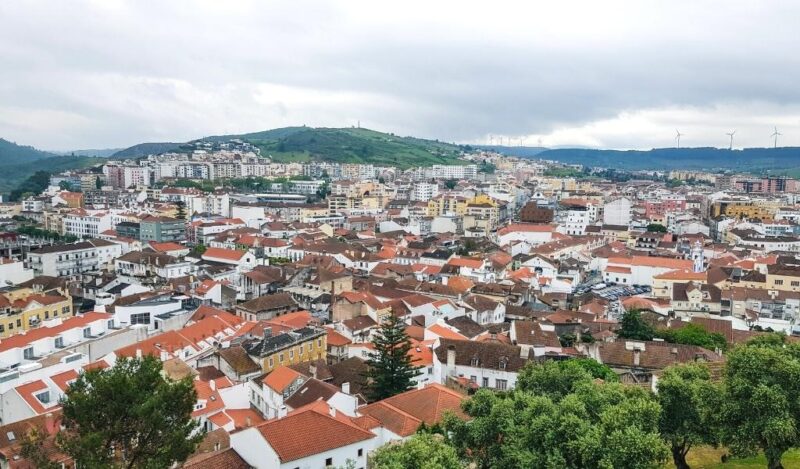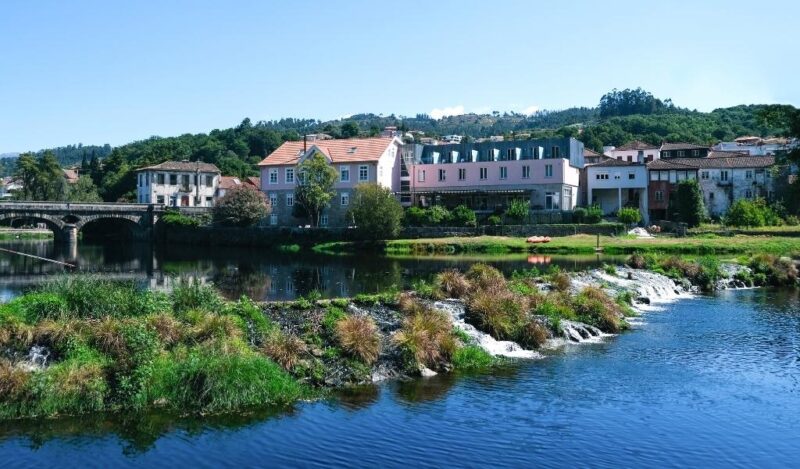Located in Sabugal in the Guarda district, the small mountain village of Sortelha is one of the “12 Historical Villages of Portugal” (a program created by the Portuguese government in 1991, to restore and enhance a series of villages in the Beira Interior region, older than the country itself).
With more than 800 years of history, Sortelha is one of the oldest and most charming villages in the country, where there’s no shortage of places to discover, explore, and photograph. Here, you can visit religious temples, manor houses, and even a grand medieval castle!
So, do you want to know more about the 1 Day In Sortelha: The Perfect Sortelha Itinerary? Keep reading!
This post may contain affiliate links, meaning I earn a small commission if you make a purchase, at no additional cost to you. Please read my disclosure & privacy policy for more information.
No time to read now? Pin it for later!


Brief History of Sortelha
The history of Sortelha has more than eight centuries of history and dates back to 1228, the year in which it received a Charter by King Sancho II. From that moment onwards, the Sortelha Castle began to be built, leading to the development of the first urban center within the walls, between the 13th and 14th centuries.
During the reign of King Manuel I (1495-1521), the town of Sortelha was the target of extensive restructuring and requalification work. And in response to population growth, the first residences and administrative structures outside the Castle began to be built, including the Pillory, the Town Council and Prison, and several manor houses.

Over the centuries, the strategic location of the Sortelha Castle served its defensive purpose, above all as a lookout post. However, in 1855, Sortelha lost its status as the municipality seat, leading to the depopulation of the region. Currently, the historical village has less than 500 inhabitants and most of them live outside the walled enclosure.
Visiting Sortelha
To visit Sortelha, you’ll need a car – or motorbike, bicycle, campervan, whichever you prefer! And if you want to combine a visit to two historical villages on the same day, I recommend Belmonte, Monsanto, or Idanha-a-Velha (20, 52, and 55 km away, respectively).
Honestly, some of the 12 Historical Villages of Portugal can be visited in one morning or afternoon, as is the case of Castelo Mendo, Idanha-a-Velha, Linhares da Beira, Marialva, Piódão, or Sortelha. As for the others, it depends on the number of monuments you want to include in your itinerary.
Since Almeida, Belmonte, Castelo Novo, Castelo Rodrigo, and Monsanto are towns, it’s likely that you’ll need a day (or two) to explore them from one end to the other. And the same happens with Trancoso, which is a city. By the way, here’s the list of the 12 Historical Villages of Portugal:
- Almeida, in the Guarda district
- Belmonte, in the Castelo Branco district
- Castelo Mendo, in the Guarda district
- Castelo Novo, in the Castelo Branco district
- Castelo Rodrigo, in the Guarda district
- Idanha-a-Velha, in the Castelo Branco district
- Linhares da Beira (or simply Linhares), in the Guarda district
- Marialva, in the Guarda district
- Monsanto, in the Castelo Branco district
- Piódão, in the Coimbra district
- Sortelha, in the Guarda district
- Trancoso, in the Guarda district
Sortelha Itinerary
“Old Lady’s Head”
In my opinion, one of the best things to do in Sortelha is to look for the so-called “Old Lady’s Head” in the middle of the mountainous landscape.
For that reason, this was the first point we visited, after arriving in the historical village.
This area of the interior of Portugal is marked by granitic formations – many of them thousands and thousands of years old.
And if the vast majority goes unnoticed by locals and tourists, this has the opposite effect!

The “Old Lady’s Head” in Sortelha got its name precisely because the rock resembles the head of an elderly woman. However, the most imaginative minds say that it’s not just any “old lady”, but rather a witch with a pointed nose and a prominent chin!
Misericórdia Church

The Misericórdia Church of Sortelha (ie, Mercy Church) is also known as Saint Rita’s Church or Saint John’s Church.
Built possibly at the beginning of the 14th century, the Misericórdia Church is located outside the walls of Sortelha and a few meters from the former Misericórdia Hospital, in Saint Rita’s Square.
Unfortunately, the temple has been in ruins for decades and doesn’t even have a roof anymore. If you want, you can take a look at the interior, which consists of a single nave and features traces of the altar.
New Gate & False Gate
After exploring these monuments to the west of Sortelha’s walled enclosure, you can choose one of two gates to enter the historic center: the New Gate or the False Gate. If you choose the New Gate, don’t forget to admire a stretch of Medieval Paving, paved with granite!
Facing Saint Rita’s Square, the New Gate is the oldest of the three gates of this historical village (despite its name). On one of the sides, you can still find two of the old Portuguese measurement units, which the country used from the Middle Ages until the introduction of the metric system, in the 19th century!


The False Gate is a little further north, leaning against the Facho Tower. This rectangular tower, almost 10 meters high, was built to control access on this side of the wall, as well as to communicate with other castles in the vicinity (such as Belmonte and Monsanto).
As far as is known, the False Gate was not much used and was even closed, so as not to compromise the defense of the historical village of Sortelha (hence the name “False”). If you want to climb the walls, this is the perfect place to see the “Old Lady’s Head”!
Governor’s House
The Governor’s House is one of the buildings in the best state of preservation in the historical village of Sortelha. Dating back to the 15th-16th centuries, it consists of two floors with different purposes: the ground floor housed shops and the main floor was the residence of the Governor of the Municipality.

Located on the main streets of the village, the Governor’s House is within walking distance of the most important structures and institutions in Sortelha: the Church of Our Lady of the Snows (or Parish Church), the Pillory, the Town Hall, and Prison, and even the Castle.
Church of Our Lady of the Snows (or Parish Church)
A Igreja Matriz de Sortelha é dedicada à Nossa Senhora das Neves, uma das várias invocações católicas da Virgem Maria. Erigida no século XVI, naquele que é o atual Largo da Igreja, o monumento está rodeado por uma Torre Sineira e um dos Passos da Via Sacra (este último, junto a sepulturas antropormórficas escavadas na rocha).
The Parish Church of Sortelha is dedicated to Our Lady of the Snows, one of the various Catholic invocations of the Virgin Mary. Erected in the 16th century, in what is now Church Square, the monument is surrounded by a Bell Tower and one of the Stations of the Cross (the latter, over some graves sculpted in the rock).

Although the year “1573” is inscribed on the main façade, the Church of Our Lady of the Snows has undergone several renovations and modifications over the centuries. For example, inside, you can see decorative elements from the Gothic, Renaissance, Mannerist, and even Joanine periods (that is, late Portuguese Baroque).
Sortelha Castle
To enter the Castle, you’ll have to pass by the Pillory and Town Council and Prison (currently the Parish Council), right in the “heart” of Sortelha. But as these two sights were undergoing renovation work when I visited the historical village, I decided not to include them in this travel itinerary.
The Sortelha Castle is an imposing and robust fortification, built at an altitude of 760 meters, on a large rock formation. It’s not known for sure on what date the works were completed, but it must have been after the town received the Charter in 1228.


For this reason, its architecture is markedly Romanesque and Gothic – even though it was the target of interventions in the Manueline period (that is, in late Portuguese Gothic). Proof of this is the royal arms of King Manuel I, carved above the Castle Gate.
Classified as a National Monument in 1910, the Sortelha Castle is the best-known postcard of this historical village. In the center of the old military fortress, stands the Keep, which seems to be “born” from the granite boulders!
Azenha Fountain
Another of the best things to do in Sortelha is to look for its fountains. In addition to the Cistern inside the Castle, the old town received water from two fountains: the Azenha Fountain and the Mergulho Fountain.
Well, the first one is a little hidden, but you have two route options: either follow the main street after the Pillory and turn left; or walk straight ahead, from the back of the Parish Church.
In addition to being discreet, the Azenha Fountain is a peculiar structure, as it has a tank carved out of a boulder! The Mergulho Fountain is part of the popular Corro Square and is made up of a modern iron pump.

“House Number 1”
“House Number 1” is named after an inscription on one of the ground-floor doors. There’s no certainty as to whether this house is one of the oldest (or even the oldest) in the historical village of Sortelha – which could justify the numbering.
The two-story building that has survived to the present day appears to have been built between the 16th and 18th centuries. However, there are records that the origins of this house date back to the 13th century, when it belonged to the Ferreira Ferraz family, the former governors of Sortelha.

“House Number 1” is located in Corro Square, the “busiest” place in Sortelha. Here, you’ll find some of the most prestigious residences in the old town, such as the House of the Town Clerk or the Falcões House – not to mention the Mergulho Fountain or the Tourism Office of Sortelha.
Among the best things to do in Sortelha, discovering the various corners of Corro Square is, without a doubt, one of them. One of the most interesting points of interest is the European nettle tree, a centenary tree classified as a Tree of Municipal Interest in 2017 and whose scientific name is “Celtis australis”.
Falcões House
The last stop on this Sortelha itinerary is the Falcões House, on one of the corners of Corro Square. This two-story residence (a commercial ground floor and a residential upper floor) dates back to the 16th century, although it was renovated in the 18th century.

Like almost all other buildings and structures in Sortelha, the Falcões House uses granite as raw material and other typical materials from this region of Central Portugal. A few steps away, you’ll find the Town Gate, the main entrance to the historical village, and the third on this travel itinerary.
Map of the Sortelha Itinerary
Share this blog post on your social media!
More Posts about Portugal
4 Best Monasteries In Portugal (That You Should Visit This Year)
5 Best Palaces In Sintra (That You Should Visit This Year)
1 Day In Penafiel: The Perfect Penafiel Itinerary
More Posts about Travel Itineraries
1 Day In Penafiel: The Perfect Penafiel Itinerary
1 Day In Torres Vedras: The Perfect Torres Vedras Itinerary
2 Days In Arcos De Valdevez: The Perfect Arcos De Valdevez Itinerary
What Photography Gear Do I Use?
- Camera Body: Fujifilm X-T4 Mirrorless
- Camera Lens: Fujinon XF 18-55 mm F2.8-4 R LM OIS
- Tripod: Manfrotto Compact Action
- Small Tripod: Manfrotto PIXI Mini
- Smartphone Adaptor: Manfrotto PIXI Clamp
- Memory Card: SanDisk 128GB Extreme PRO SDXC





